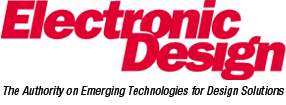
October 16, 2000
Speedier High-Resolution Data Converters Make Software Radios Feasible
As more and more signal processing is done in the digital domain, analog-to-digital conversion is moving closer to the antenna.
by Ashok Bindra
Analog, Power Devices & DSP
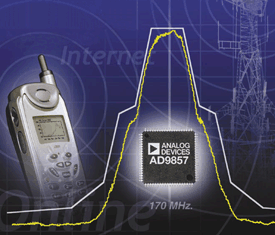
Art courtesy of Analog Devices Inc.
Recent improvements in front- and back-end data converters have accelerated the acceptance of digital or software-defined radios in the commercial world. These improvements have filled an existing void after the availability of low-cost DSPs facilitated the transition for designing such radios. That has prompted cellular communications technology to take the digital route. Now, similar efforts are under way to speed the development of AM and FM digital radio broadcasts in the U.S. and the rest of the world, using the existing terrestrial in-band system. In Europe, though, out-of-band digital audio broadcasting (DAB) via satellites has been impacting the airwaves for nearly a decade. Several international consortiums are spearheading that effort across the globe, as digital alternatives to the terrestrial mode of transmission.
Thanks to the U.S.-based WorldSpace Corp., satellite digital radio has been in service in Africa for over a year. This was made possible by the launch of the AfriStar satellite. Additionally, satellite DAB broke ground in Asia last month via the AsiaStar satellite, which was launched in March. Primarily, WorldSpace's digital radio transmission and receiver technology is aimed at stationary receivers in the homes and offices of developing countries.
Furthermore, satellite radio broadcasting is in the works in the U.S. But unlike WorldSpace, XM Satellite Radio and Sirius Satellite Radio are aggressively racing to beam their signals toward automobiles. In short, they are preparing to provide satellite-to-car or mobile radio broadcasting services by early next year.
In 1997, the U.S. FCC licensed the S-band spectrum to XM and Sirius for national satellite radio broadcasts. These service providers have aligned themselves with major analog/mixed-signal and DSP chip suppliers to generate digital radio transmission and reception circuits in compliance with their system architectures and broadcast services.
For instance, Lucent Technologies is developing RF, analog/mixed-signal, and DSP chips for the Sirius digital radio receiver for satellite-to-car receiver sets. "We have been working with Sirius for two-and-a-half years, developing the system and the chips," notes Rob Franzo, director of automotive products at Lucent. "It's a broadband solution with double downconversion," he adds. The incoming 2.32-GHz RF is downconverted to a 300-MHz IF, which is further converted to a 75-MHz signal for sampling. Then, this signal is digitized using a very high-performance analog-to-digital converter (ADC).
By implementing a pipelined architecture in deep-submicron CMOS, Lucent is readying a 14-bit, 60-Msample/s ADC for this application as part of the chip-set solution for the satellite receiver. It will be followed by a digital downconverter (DDC) that will format the digital data for linking with the Lucent DSP.
In this design, the carrier frequency uses a 12.5-MHz bandwidth to incorporate two satellite signals that employ quadrature phase-shift keying (QPSK) modulation, time-division multiple-access (TDMA) digital encoding, and a single terrestrial signal employing coded orthogonal frequency-division multiplexing (COFDM) techniques. No further details on the chips were provided, however, and the developer didn't give out any hints about when the chip set will be ready for delivery.
On the other hand, STMicroelectronics has lined up a deal with XM. Under an agreement with the satellite radio service provider, STMicroelectronics is developing a chip set for mobile and home radio receivers, which includes the RF/analog front end and the DSP-based baseband processor. In essence, STMicroelectronics is extending the experience that it gained by designing the WorldSpace digital satellite receiver using the 0.25-µm CMOS process.
Fortunately, the merger of two leading technology developers of terrestrial digital radio broadcasting will soon make DAB a reality in the U.S. Today, radio broadcasting in the U.S. implements analog signals with amplitude modulation (AM) and frequency modulation (FM) techniques. The transition toward digital modulation will transform terrestrial radio broadcasters into providers of enhanced-quality sound for AM radio and CD-quality audio for FM users, as well as data for a variety of consumer applications. Without diminishing the quality of current analog transmissions, the new DAB system will initially deliver a hybrid solution. It will ensure that the presently installed base of traditional analog broadcasts won't be obsoleted immediately. This solution provides a smooth transition toward ultimately pure DAB service.
To expedite this effort, Lucent Digital Radio and USA Digital Radio recently unwrapped plans to combine forces and operate as a single entity under the name iBiquity Digital Corp. This merger is expected to speed up the standardization effort and pave the way for rapid development and commercial deployment of AM and FM in-band on-channel (IBOC) digital radio in the country.
Conversion Without Disruption
IBOC digital audio broadcasting uses the current radio spectrum to transmit AM and FM analog simultaneously with high-quality digital signals. As a result, it will enable broadcasters and listeners to convert from analog to digital radio without service disruption. Plus, current dial positions of existing stations will be maintained with IBOC.
The emerging digital radio broadcast standard, coupled with the emerging multiprotocol, multistandard cellular/PCS phone, is forcing analog and mixed-signal IC suppliers to develop integrated analog front-end chips for these applications. So when the standards are established and the market is ready to take off, the analog front ends will be there to facilitate the digital radio revolution. In conjunction with DSPs, these IC suppliers are developing software-radio architectures that can be reprogrammed for different modulation formats and transmission standards. The end result is one software radio for multiple standards.
Toward that end, analog front-end IC suppliers are spawning faster ADCs and digital-to-analog converters (DACs) with higher resolution, better dynamic range, and lower noise performance. Above all else, they're achieving wider input bandwidths at higher frequencies (Fig. 1). It's the data-converter's sampling/update rate, its spurious-free dynamic range (SFDR), and its signal-to-noise ratio (SNR), in conjunction with the speed of the DSP, that will determine where digitization will begin--at RF, IF, or the baseband.
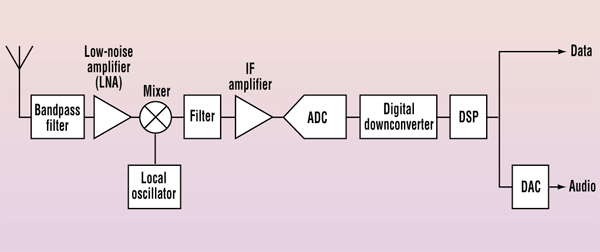
1. For a given radio service and frequency band, the ADC's
speed, resolution, and dynamic performance determine whether the digitization
will occur at the RF or IF or in the baseband. Today's high-performance
14-bit ADCs are enabling designers to digitize at the first IF level.
Concurrently, developers are investigating the integration of high-performance ADCs with DDCs to ease the task of interfacing these converters with follow-on baseband DSPs in the receive path of the communication chain. Additionally, similar strategies are in progress at the transmit end, where a digital upconverter will be linked with a high-resolution, high-speed DAC on the same chip. Although the current process geometries and circuit techniques inhibit such integration, the potential improves as designers migrate below 0.35-µm CMOS processes.
Furthermore, suppliers say that DACs don't present the same hurdles as the ADCs for this level of integration. Subsequently, the initial thrust will be to integrate digital upconverters with 14- and 16-bit, high-speed, high-performance DACs on the same substrate for the transmit chain of wireless digital radio communication systems.
On the integration front, Analog Devices Inc. (ADI) has overcome hurdles and reached new territory. Last month, the company revealed a 200-Msample/s 14-bit quadrature digital upconverter that packs a high-speed direct digital synthesizer (DDS), a high-performance, high-speed 14-bit DAC, a clock multiplier, digital filters, and other functions on a single CMOS chip. The AD9857 accepts complex I/Q data, unsamples the data, quadrature-modulates the data onto a carrier, and outputs a frequency-agile modulated carrier in the analog domain.
In essence, it moves much of the transmit path from the analog domain to the digital domain and enables a futureproof approach to system partitioning and RF interfacing. "Changes to interface standards and system enhancements are incorporated in a simple spin of the digital ASIC, whereas the RF interface remains the same, and hence futureproof," notes Charles O'Roark, digital synthesis product line manager at ADI.
Offering an 80-dB SFDR, the AD9857 generates up to an 80-MHz fundamental signal from a digital input. Included in the architecture is a 4X to 20X programmable reference clock multiplier, along with a PLL lock-detect indicator that can operate in three modes--quadrature modulator, single-tone, or interpolating DAC. The AD9857 operates from a single 3.3-V supply and comes in an 80-lead LQFP.
The goal of data-converter designers is to turn toward smaller CMOS geometries in order to accomplish the best combination of performance, power, size, and cost. Consequently, as they begin to tap 0.25-µm and finer CMOS processes, they will be motivated to bring RF functions, such as mixers, local oscillators, and amplifiers, on-chip. Those who are looking into the future foresee the integration of RF functions with front-end ADCs and DDCs as a start. Next, this evolution will bring the baseband DSP processor on board to deliver a complete integrated digital radio receiver. For a handset application, the designers also will place the DAC on board, thereby turning the on-chip ADC and DAC into a full-fledged radio transceiver.
Several key analog and mixed-signal IC makers have targeted these emerging applications. They're making a variety of analog front ends ready for these emerging markets. Most notable is ADI, with its SoftCell multicarrier transceiver chip set (Fig. 2).
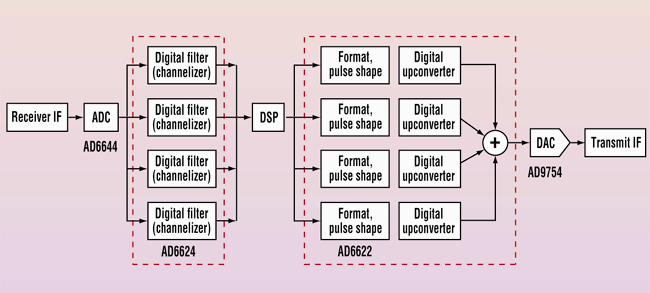
2. ADI's SoftCell is a complete IF-to-digital transceiver
chip set. It consists of a 14-bit 80-Msample/s ADC with a 100-dB dynamic
range over the Nyquist band and 77-dB signal-to-noise ratio. It includes
a four-channel digital RSP, a quad digital TSP, and a 150-MSPS 14-bit transmit
DAC. Although the SoftCell is aimed at multicarrier, multimode infrastructure
applications, its architecture can be exploited by emerging digital radio
standards.
According to the company, the SoftCell is a functionally complete end-to-end, IF-to-digital transceiver chip set that enables true software radio to be deployed for wireless-infrastructure applications. The SoftCell is comprised of a 14-bit ADC, the AD6644, with an 80-Msample/s sampling rate, a 100-dB dynamic range over the Nyquist band, and a 77-dB SNR. This is followed by a digital receive signal processor (RSP), the AD6624, which performs the channel tuning, filtering, and decimation required to provide baseband I and Q signals to the DSP. The RSP's four channels are independently programmable to change interface characteristics on demand.
For additional channel capacity, RSPs can simply be connected in parallel. "The superior dynamic range and SNR performance of the AD6644 eases the burden on multimode digital receivers or software radios, which are typically limited by the ADC," remarks Brad Brannon, systems engineer at ADI's Digital Radio Group. "Recent advances in converter performance are allowing the designers to move the ADC closer to the antenna, thereby simplifying the RF section and doing more and more signal processing in the digital domain," adds Brannon.
Whereas the AD6644 exploits ADI's high-speed complementary bipolar (XFCB) process, the AD6624 is made on a CMOS process. For the transmit chain, the SoftCell offers a 14-bit transmit DAC, followed by a quad-digital transmit signal processor (TSP), the AD6622. In this scheme, the TSP takes the I and Q inputs from a DSP and generates the digital data necessary to drive the 14-bit transmit DAC AD9754. Based on 0.35-µm CMOS, this DAC is optimized to accurately convert multiple carriers to a single IF.
A broadband digital receiver/transmitter solution, the SoftCell can be applied to a wide range of applications. Although it's presently aimed at cellular/PCS, wireless local loop (WLL) micro/pico cell, and smart antenna applications, it has the performance to meet the requirements of emerging digital AM/FM transmitters and receivers. Because the SoftCell enables RF channels to be consolidated within a single ADC, the front-end section is smaller and less expensive to manufacture. Its programmable digital tuners and filters handle channel selection and corresponding modulation standards so that multiple air interfaces with the same chip set are permitted.
The broadband multicarrier SoftCell complements ADI's diversity receiver chip set, which has set its eye on narrow-band single-carrier approaches. The chip set, which includes the dual-channel gain-ranging AD6600 ADC and the AD6620 DDC, allows direct IF sampling of signals up to 250 MHz.
Other Vendors In The Game
Whether single or multicarrier, ADI is prepared to deliver analog front-end solutions, including DSPs, to rapidly emerging software-radio applications. Other vendors aren't far behind either. National Semiconductor Corp., for example, has entered the fray with the release of its diversity receiver chip set for digital cellular basestations.
The company's five-chip set comprises two CLC5526 digital variable-gain amplifiers, two CLC5956 12-bit 65-Msample/s ADCs, and one CLC5902 DDC with integrated automatic gain control. Together, the chip set supports two independent channels, performing ADC, DDC, and processing functions of baseband signals in the digital domain (Fig. 3).
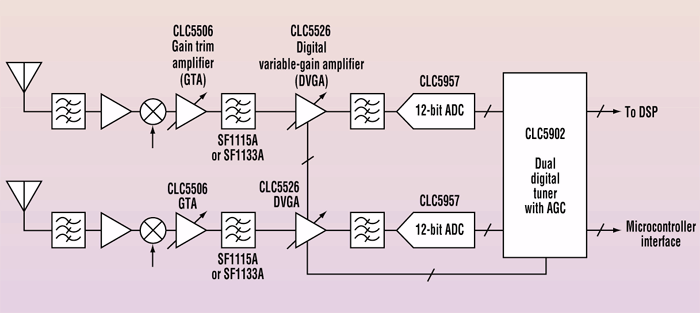
3. National Semiconductor's diversity receiver chip set is
aimed at narrow-band digital cellular basestations. This five-piece set
supports two independent channels. It performs 12-bit 70-Msample/s conversion
of the IF signal, which is next processed by the digital tuner, before
sending the data to the DSP.
"Digitizing the IF up to 300 MHz eliminates the need for multiple stages of analog frequency downconversion hardware, like mixers, filters, and amplifiers," states Kurt Rentel, marketing director for National Semiconductor's Data Conversion Systems Product Group. The set is specified with a total dynamic range of 120 dB, ensuring that the solution is adequate for applications beyond cellular basestations. The company intends to extend its use to areas like WLL basestations, as well as satellite digital receivers.
The ADC plus DDC on-chip is still an open question for the company. But in the meantime, National Semiconductor is exploring the possibility of combining the two ADCs in the diversity receiver chip set on a single die. At the same time, the company is planning to merge the two digital variable-gain amplifiers on-chip. Lower power and cost versions are on the company's roadmap too.
Other semiconductor vendors racing with time to meet the analog and mixed-signal demands of the flexible software-programmable radio include AKM Semiconductor, Linear Technology Corp., Maxim Integrated Products, Texas Instruments Inc., Intersil Corp., and STMicroelectronics Inc. With the acquisition of Burr-Brown, Texas Instruments has actually acquired some high-speed 14-bit ADCs and DACs that complement its 12-bit line. They fit nicely with the company's DSPs to serve the digital and software-radio applications. The company also is teaming up with DDC/DUC makers, like GrayChip, to develop total solutions for this marketplace.
Recently, GrayChip upgraded its digital downconverters and upconverters to the quad level to address the multistandard needs of digital cellular systems. The GC4016/4116 are building blocks for implementing multistandard (in-cluding 3G) wideband software radios for cellular basestations, as well as WLL systems. Together, the partners are readying a joint reference de-sign for the application.
Likewise, Intersil has crafted a strategy to extend its reach into expanding software-radio receivers and transmitters. The latest outcome is the Intersil CommLink family of high-speed converters and fixed-function DSPs targeting communications-infrastructure needs. Delivering a complete software-radio solution for basestation designs, the CommLink offers a quad-programmable DDC (HSP50216), a quad-programmable DUC (HSP50217), a 14-bit ADC (HI5980), plus a 14-bit DAC (HI5960). The programmable quad DDC and DUC are designed for multiple-channel processing in a small physical space. They include all of the pre- and post-processing functions needed to complete the entire channelization and conversion processes within the basestation.
In response to system designers' needs, board maker Pentek has been exploiting these advances to develop multichannel narrow/wideband digital receivers, as well as transmitters, for software radio applications. For instance, the company's four-input narrow-band receiver model 6230 combines ADI's 14-bit, 65-Msample/s ADC AD6644 along with GrayChip's eight quad digital receiver GC4016 and field-programmable gate-arrays (FPGAs) on a single board to realize a four-input 32-channel narrow-band analog front end for software radio.
"There's a trend toward combining multiple functions on a single board to achieve maximum density and minimum cost per channel," states Roger Hosking, Pentek's vice president. "Getting the sampling rates up, accuracy better, cost per channel lower, density higher, and maximizing the bandwidth between the digital receiver and the DSP are some of the key challenges confronting makers of analog front- end boards," summarizes Hosking.
While the majority of suppliers are focused on expanding the digital wireless role, Philips Semiconductor has set the pace in DAB technology for the European standard, ETS300401, which earlier was known as Eureka-147. Philips just launched a two-chip set for this version of digital radio broadcasting. This set comprises a channel decoder and an MPEG audio source decoder. According to Philips, it provides a cost-effective platform for companies that are planning to deliver DAB gadgets. Complying with the European ETS300401 standard, the company says that the chip set is suitable for constructing both low- and high-end receivers.
A Complete COFDM Receiver
A full-capacity channel demodulator and decoder, the SAA3500H can carry out all of the tasks required in a COFDM receiver (Fig. 4). It includes an 8-bit ADC, filtering, de-interleaving, Viterbi error correction, and subchannel selection. All synchronization loops for time and frequency are complete and can be controlled externally. Also, for control via a microcontroller, the SAA3500H features fast information channel (FIC) buffering. Automated dynamic reconfiguration of the channel multiplexer is allowed via a sub-channel selector.
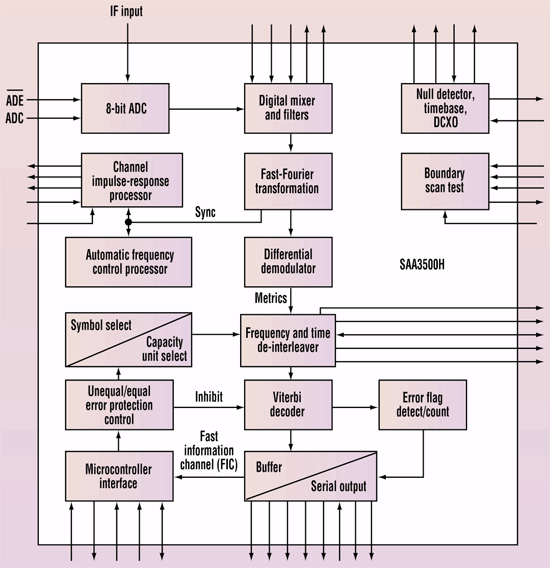
4. The SAA3500H channel decoder is part of Philips Semiconductor's
chip set for DAB receivers based on the ETS300401 standard. It performs
all tasks required for a COFDM re-ceiver. For control via a microcontroller,
the chip features fast information channel buffering.
Additionally, various application-specific interfaces are offered by the SAA3500H, such as a serial DAB3 interface, a high-speed integrated receiver data interface (RDI), and a simple full-capacity output (SFCO) interface. While the DAB3 interface connects directly to the MPEG decoder and other low-speed data decoders, the RDI and SFCO interfaces permit the use of a full-data rate for specific applications like DAB video. The SAA2502 MPEG decoder supports all DAB audio modes, including MPEG-2 low-sample rates. It includes a simple audio DAC for low-cost applications.
Once relegated to military communications receivers for gathering intelligence, the software-defined radio is now a commercial reality and is expanding its reach into all kinds of wireless communications gadgets. Thanks to advancements in analog front- and back-end ICs, the technology will soon pervade our cars, homes, and offices. But, the analog challenge isn't over yet. It has only begun.
Companies That Contributed To This Report
AKM Semiconductor - http://www.akmsemi.com/
Analog Devices Inc. - http://www.analog.com/
GrayChip - http://www.graychip.com/
iBiquity Digital Corp. - http://www.ibiquitydigital.com/
Intersil Corp. - http://www.intersil.com/
inear Technology Corp. - http://www.linear-tech.com/
Lucent Technologies - http://www.lucent.com/
Maxim Integrated Products Inc. - http://www.maxim-ic.com/
National Semiconductor Corp. - http://www.national.com/
Pentek Corp. - http://www.pentek.com/
Philips Semiconductor - http://www.semiconductors.philips.com/
STMicroelectronics Inc. - http://www.st.com/
Texas Instruments Inc. - http://www.ti.com/